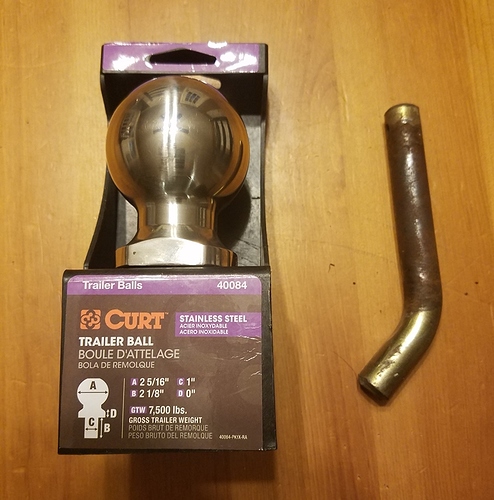It’s long annoyed me that when I slow or move, when pulling my 24’ trailer (7400-7800lbs), I can feel movement. That is to say, something isn’t tight in the hitch assembly that allows the trailer to go “thunk” towards me when I brake and then “thunk” away from me when I move from a dead stop. So today I decided to look into it.
Help, my shank is small. The first thing I found is that my hitch ball had a 1" threaded shank and I’d fastened it up, years ago, thru a 1 1/4" hole in the hitch. It’s not clear to me whether or not the 1" shank in the 1.25" hole was responsible for some of the fore/aft movement of the trailer. But as I got to looking into “why is the ball shank smaller then the hole it’s fastened into”, I found that my ball was only rated at 6000lbs. What I should have had is a hitch ball with a shank of 1.25" dia. Those are rated at 10k lbs and up. My shank is no longer small. 1.25". That’s “diameter”, baby.
The small hitch pin. The fact that there is play in my hitch pin was definitely a contributor to the irritating fore/aft movement of the trailer. It looked to me like both the receiver and the hitch shank, not ball shank but hitch shank, could handle a hitch pin about 2mm larger in dia then the 5/8" in that I’d been using forever. 2mm play in both meant 4mm of total freedom. No question that this was a contributor to the fore/aft movement.
The problem was that neither the receiver nor hitch shank was quite big enough to handle a 3/4" receiver pin. But if I could have found one today in town, I’d have drilled the holes a teensy bit bigger so that a 3/4" receiver pin would go in if one coaxed it with a hammer. So what I did instead is buy a 3/4" bolt and grind the threads down until it just barely fit thru the holes. I drilled a hole near it’s end for the retaining clip. Then I painted it to slow rust and banged that bad boy into place. I didn’t bang it with my newly larger ball shank, I used a hammer, but you know that shank was nearby.
So, not only have I removed the irritating for/aft play in the hitch, but the hitch is now significantly stronger. Win.
Pictured is a SS hitch ball with a 1" shank. I didn’t end up using it because I bought the SS ball before I realized that what I really needed was a ball with a 1.25" shank. Also in the picture is the 5/8" hitch receiver pin.



